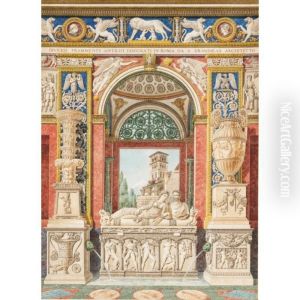Auguste Henri Victor Grandjean De Montigny Paintings
Auguste Henri Victor Grandjean de Montigny was a pivotal figure in the neoclassical architectural movement in Brazil. Born on July 15, 1776, in Paris, France, Grandjean de Montigny was immersed in the rich cultural and artistic environment of late 18th-century Europe. He was trained at the prestigious École des Beaux-Arts in Paris, where he honed his skills and developed a keen interest in neoclassical architecture, a style that sought to revive the principles and aesthetics of ancient Greek and Roman architecture. His talent and dedication to his craft were recognized early on, and he was awarded the Prix de Rome in 1799, an esteemed scholarship that allowed him to study architecture in Rome, further deepening his commitment to the neoclassical style.
After his studies in Rome, Grandjean de Montigny returned to a turbulent France, where the political and social landscape had been dramatically transformed by the French Revolution and the Napoleonic Wars. Seeking new opportunities, he accepted an invitation in 1816 from the Portuguese king, John VI, to move to Brazil. This move would mark the beginning of a significant chapter in his career and in the architectural history of Brazil. In Rio de Janeiro, then the capital of the United Kingdom of Portugal, Brazil, and the Algarves, Grandjean de Montigny became a leading figure in introducing and developing neoclassical architecture. His works contributed significantly to the transformation of the city's urban landscape, strongly influencing the architectural direction of Brazil during the early 19th century.
One of Grandjean de Montigny's most notable projects was the design of the Royal School of Sciences, Arts and Crafts, which later became known as the Escola Real de Ciências, Artes e Ofícios. Completed in 1826, this institution was pivotal in promoting the arts and architecture in Brazil and is considered one of the first and most important neoclassical buildings in the country. Throughout his career in Brazil, Grandjean de Montigny designed a range of public and private buildings, including residences, schools, and churches, each reflecting his commitment to the principles of neoclassicism and his adaptation of European styles to the Brazilian context.
Auguste Henri Victor Grandjean de Montigny's contributions to Brazilian architecture were profound. He not only introduced a new architectural language but also played a crucial role in the establishment of the Imperial Academy of Fine Arts, which became a central institution for the arts in Brazil, fostering a generation of Brazilian architects and artists. Grandjean de Montigny passed away on March 2, 1850, in Rio de Janeiro, but his legacy lives on. His work not only left a lasting mark on the architectural landscape of Brazil but also contributed to the broader dialogue between European neoclassicism and the architectural expressions of the New World.
